Understanding Embalming: The Science Behind Body Preservation
Embalming define as the art and science of preserving human remains by treating them with chemicals to forestall decomposition and restore a natural appearance. This process involves three primary goals:
- Sanitization - Disinfecting the body to eliminate harmful microorganisms
- Preservation - Temporarily delaying decomposition for viewing and ceremonies
- Presentation - Restoring a peaceful, lifelike appearance for family viewing
The typical embalming process takes 2-4 hours and uses specialized chemicals like formaldehyde (5-35% concentration) and methanol (9-56% concentration) to achieve these goals. While not legally required in most cases, embalming serves both practical and emotional purposes - allowing time for funeral arrangements while providing families with what the industry calls a "memory picture" of their loved one.
From ancient Egyptian mummification dating back 5,000-6,000 years to modern funeral home practices, embalming has evolved from religious ritual to scientific procedure. Today, approximately 85% of bodies in the United States undergo some form of embalming.
As American Mortuary Coolers, we've worked with funeral directors nationwide, helping them understand the complete ecosystem of body preservation - from embalming chemicals to refrigeration systems that complement this process.
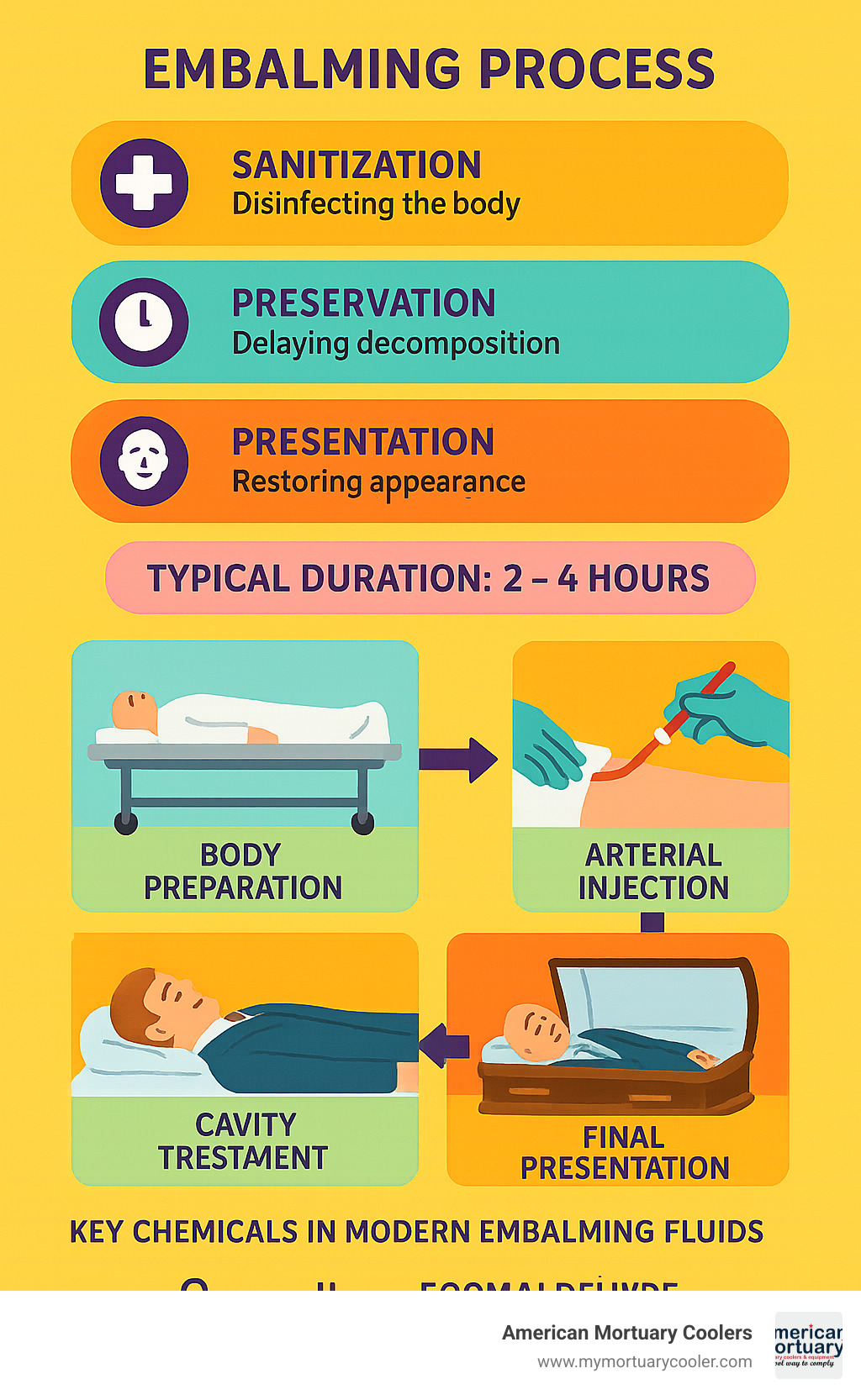
Embalming Define: What It Means and Why It Exists
To embalming define in the simplest terms, it's the process of treating a deceased person's body with chemicals to slow down decomposition and make it safe for viewing. Think of it as a temporary pause button that gives families time to say goodbye while keeping everyone healthy and safe.
The process became sophisticated after 1855, when scientists finded formaldehyde. This chemical became the backbone of modern embalming, still used today in concentrations ranging from 5% to 35%. Modern embalming fluids contain methanol (usually 9-56%), glutaraldehyde, humectants to prevent skin drying, and dyes to restore natural coloring.
Embalming creates an "antiseptic condition" throughout the body. It's not just about preservation - it's about bringing back that peaceful, natural appearance that helps families remember their loved one as they were in life.
For details on how this works, A Guide to the Embalming Process Explained breaks down the step-by-step process.
Core Goals of Embalming
Sanitization eliminates bacteria and viruses that could be dangerous during viewings. When embalmers inject disinfecting chemicals into blood vessels, they're creating a safe environment for families and funeral staff.
Preservation gives families time to gather relatives, plan services, and handle details without feeling rushed. Embalming keeps the body in good condition for about a week under normal circumstances.
Presentation creates what embalmers call a "memory picture." Through careful cosmetic work and positioning, they help the deceased look peaceful and natural - like themselves on a good day.
Key Chemicals and Their Functions
Formaldehyde is the main preservative that stops bacterial breakdown of proteins. Standard cases use 5-15% formaldehyde, while challenging situations may require up to 35%.
Methanol helps distribute chemicals evenly throughout tissues while removing excess moisture that bacteria need to survive.
Glutaraldehyde provides additional preservation power, especially useful for long-term preservation needs.
Humectants prevent skin from becoming dried and leathery, maintaining natural texture.
Dyes help embalmers track fluid distribution and restore natural skin color lost during illness or after death.
Safety protocols around these chemicals have improved significantly. Scientific research on formaldehyde exposure has pushed the industry toward better safety measures and lower-formaldehyde alternatives.
From Pharaohs to Funeral Homes: A Brief History
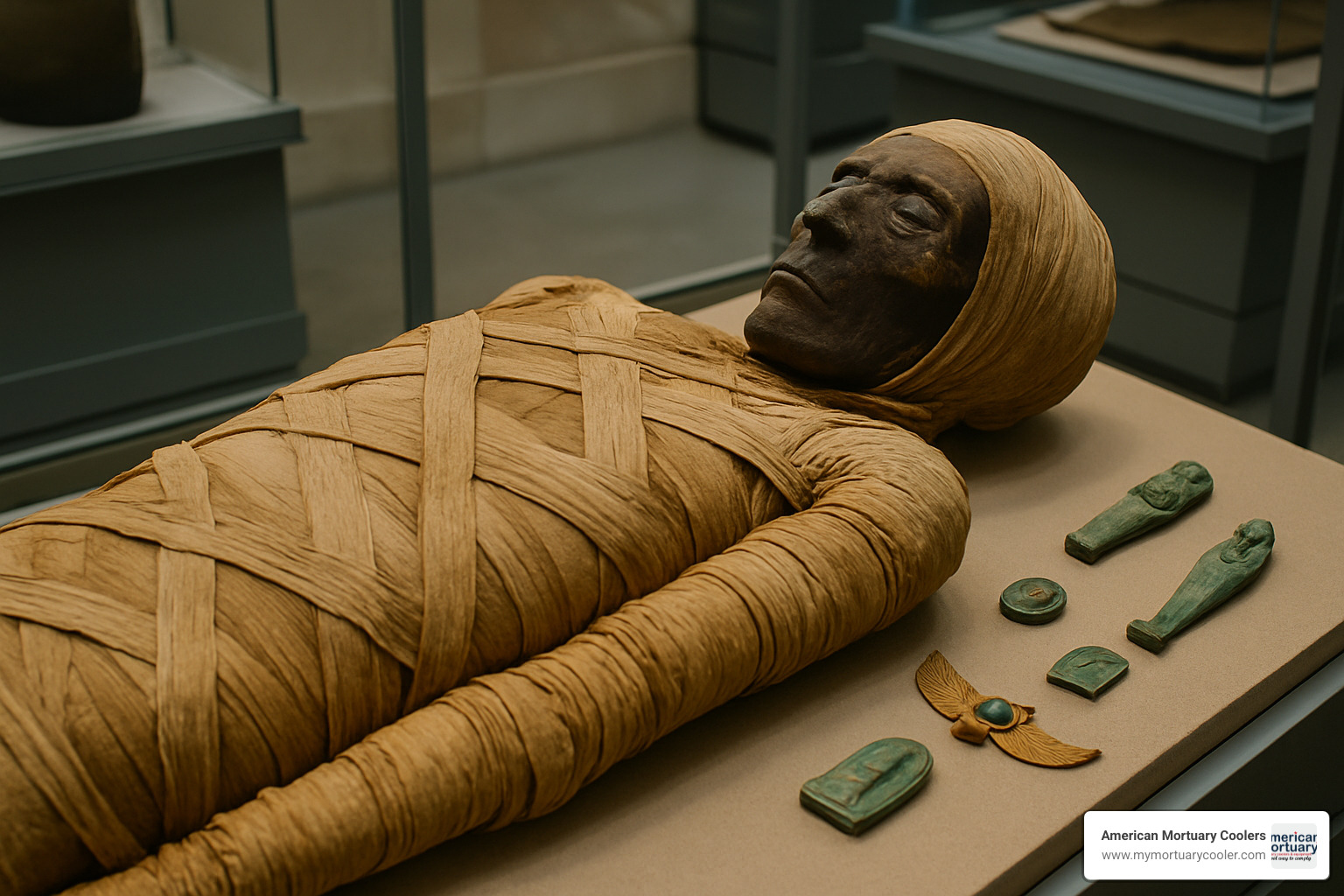
The story of how we embalming define today begins thousands of years ago. The earliest known artificial mummification started with the Chinchorro culture in Chile and Peru, dating back 5,000-6,000 years - over 2,000 years before Egyptian mummification became famous.
Ancient Egypt turned body preservation into an art form. During the New Kingdom period (1738-1102 BCE), Egyptian embalmers developed sophisticated techniques: removing internal organs, drying bodies in natron salt for 70 days, then wrapping in linen with oils and resins. Many Egyptian mummies remain remarkably preserved today.
The Romans used cavity embalming methods, injecting preservative solutions directly into body cavities. This maintained natural appearance during their extended funeral ceremonies.
During medieval times, embalming was rare and mostly reserved for royalty, using wine, vinegar, or honey as preservatives.
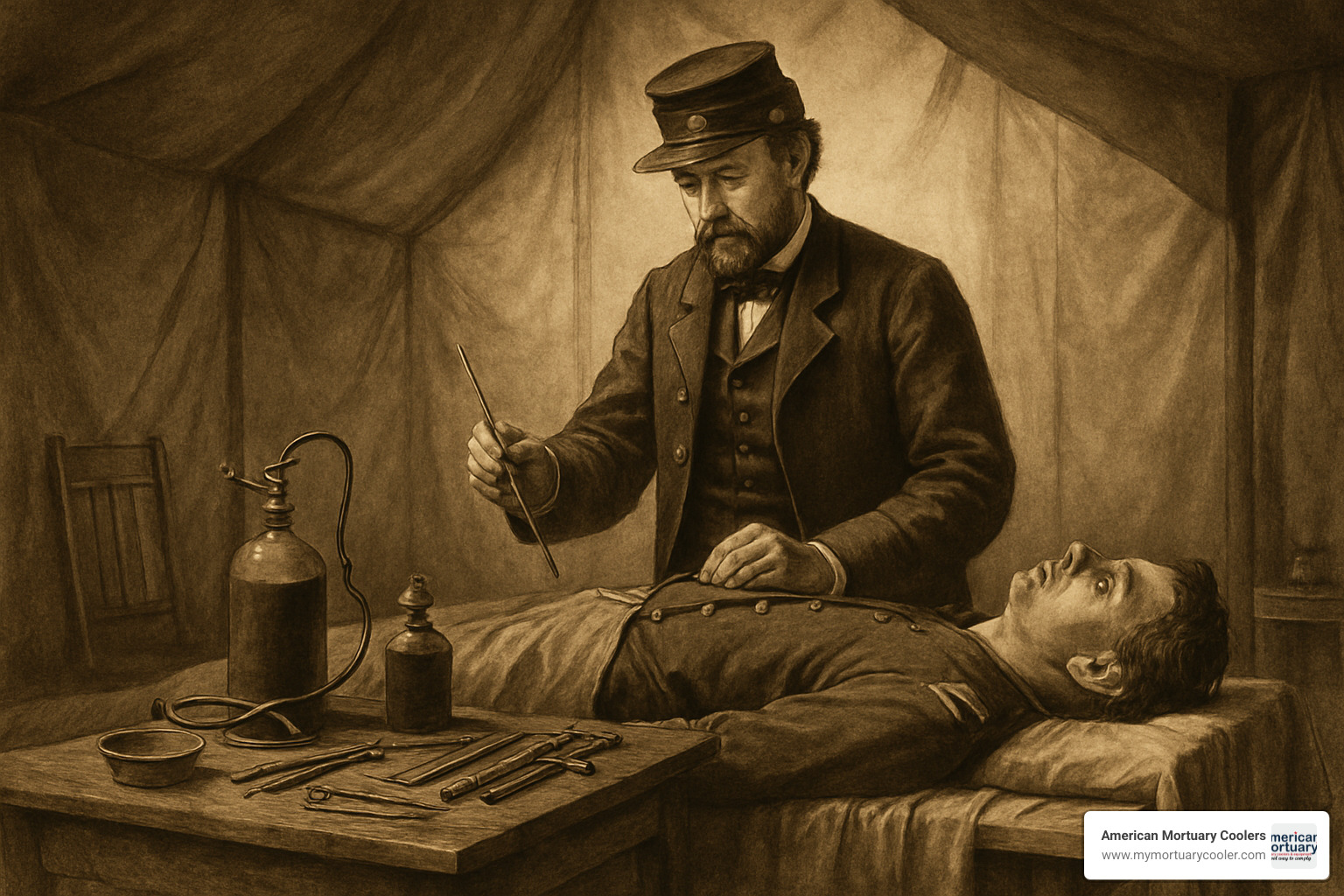
Everything changed during the American Civil War. Dr. Thomas Holmes pioneered field embalming techniques that allowed fallen soldiers to be preserved and sent home to families. This created the modern embalming industry in America.
The game-changer came in 1855 with the findy of formaldehyde. This chemical proved far more effective than anything used before. By the early 1900s, formaldehyde-based embalming had become standard practice across North America.
Famous cases demonstrate embalming effectiveness. Vladimir Lenin's body has been preserved for nearly a century in Moscow. Abraham Lincoln remained recognizable 36 years after embalming when officials opened his coffin.
Today's modern era continues this evolution with eco-friendly alternatives and improved safety protocols. You can see modern approaches in Pope Francis Embalming: The Science of Body Preservation.
From ancient rituals to modern science, embalming shows how human needs for dignity and proper farewell have remained constant while methods evolved dramatically.
Modern Embalming Process Step-By-Step

Modern embalming define process has evolved into a systematic approach taking 2-4 hours from start to finish. The preparation room features proper ventilation, temperature control, and sterilized equipment with medical-facility precision.
Modern embalming depends heavily on maintaining proper temperature throughout the process. Mortuary coolers keep bodies at optimal temperatures before, during, and after embalming, directly impacting how well preservation chemicals work.
Quality equipment integration makes the difference in achieving consistent results. From specialized pumps controlling fluid pressure to precision instruments minimizing tissue damage, every tool serves a specific purpose.
Understanding the complete supply chain helps funeral directors optimize operations, as detailed in Everything You Need to Know About Embalmer Supply Companies.
Embalming Define in Practice: 5 Critical Steps
Verification of death checks for multiple signs including rigor mortis, lividity patterns, clouded corneas, and complete absence of vital signs. This safety measure prevents the extremely rare error of treating someone who isn't actually deceased.
Vessel raising requires anatomical expertise. The embalmer locates and exposes major blood vessels, usually choosing the right common carotid artery for injection and right jugular vein for drainage. This requires steady hands and deep anatomical knowledge.
Injection phase combines chemistry with artistry. Embalming fluid enters the arterial system under controlled pressure (3-12 psi). The embalmer monitors fluid distribution, adjusting pressure and using massage techniques for even circulation.
Aspiration uses a trocar to remove gases and fluids from body cavities. Concentrated cavity fluid then gets injected to preserve internal organs and prevent "purging."
Cosmetology transforms technical preservation into something comforting for families. This involves setting facial features naturally, applying cosmetics restoring healthy coloration, styling hair, and dressing the body to create that peaceful "memory picture."
Tools & Tech in the Prep Room
Trocars remain essential for cavity treatment, allowing embalmers to remove fluids and inject preservatives through small, discrete incisions.
Centrifugal pumps revolutionized injection control. These machines monitor pressure and flow rates in real-time, allowing adjustments for optimal fluid distribution.
Eye caps and mouth formers help set facial features naturally, while specialized adhesives and sutures maintain proper positioning throughout preservation.
Mortuary coolers extend working time, improve chemical-tissue interaction, and maintain optimal conditions throughout embalming. Temperature control directly impacts preservation quality.
Precision instruments enable clean, accurate work. Tools like those in An Essential Guide to Metzenbaum Scissors ensure clean incisions, minimizing restoration work and improving final appearance.
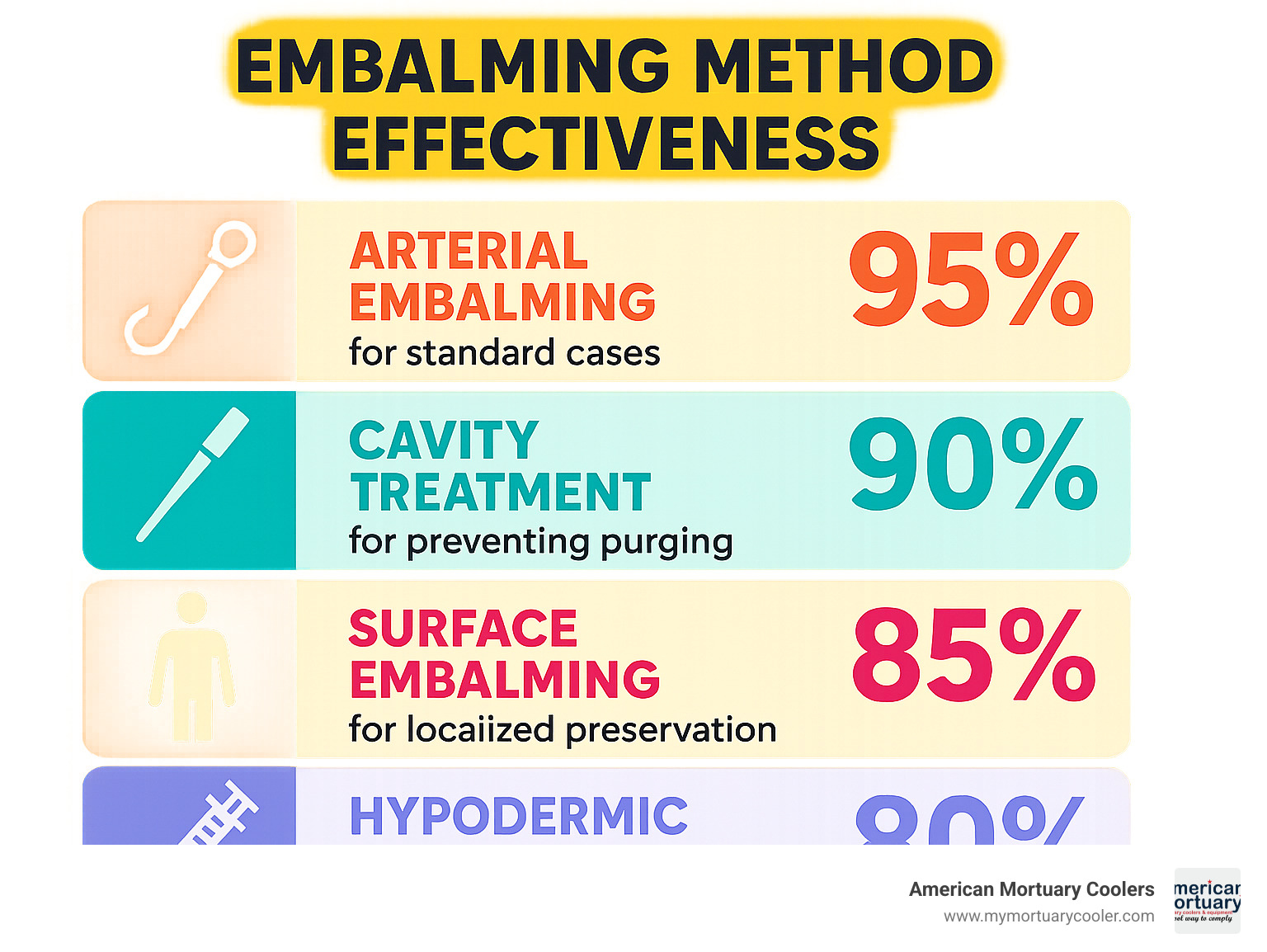
Laws, Culture & Environment: When You Need It (Or Not)
Embalming regulations vary dramatically by location and circumstances. Federal law takes a hands-off approach but the FTC Funeral Rule demands transparency. Funeral directors must disclose pricing, get written family approval, and explain when embalming is legally required versus recommended.
State regulations differ significantly. Florida's 24-hour rule requires either embalming or refrigeration if holding a body more than 24 hours after death. Most states have similar time-based requirements, usually 24-72 hours.
International travel changes everything. Most countries mandate embalming for human remains entering their territory, making it essentially non-negotiable for repatriation cases.
Environmental concerns have sparked conversations about traditional embalming practices. Research in Scientific research on environmental impact of embalming examines how formaldehyde affects soil and groundwater systems.
Cultural & Religious Perspectives
Christianity generally accepts embalming as practical rather than theological. Most denominations view it as helping families during grief, though some Eastern Orthodox jurisdictions prohibit it except when legally required.
Judaism traditionally opposes embalming because it interferes with natural decomposition processes holding religious significance. Reform and Conservative communities may permit it when practical needs require it.
Islam prohibits embalming in most circumstances, emphasizing rapid burial and natural decomposition as religious law. Exceptions occur only when government authorities legally mandate preservation.
Hinduism generally discourages embalming, preferring cremation within 24 hours. The faith emphasizes spiritual liberation over physical preservation.
The Bahá'í Faith prohibits embalming except when required by law, emphasizing respect for the physical body while prioritizing spiritual concerns.
Environmental and Health Considerations
Formaldehyde exposure creates documented health risks for funeral workers, with studies linking long-term exposure to increased myeloid leukemia rates. Proper ventilation, protective equipment, and exposure monitoring help protect staff.
Environmental concerns focus on formaldehyde's long-term impact on soil and groundwater near cemeteries. While immediate damage appears minimal, potential chemical accumulation raises sustainability questions.
Green alternatives include low-formaldehyde embalming fluids and essential oil-based preservatives. Refrigeration-only preservation eliminates chemical concerns while providing families time for ceremonies. Immediate burial or cremation represents the most environmentally friendly approach.
Alternatives and the Future of Body Preservation
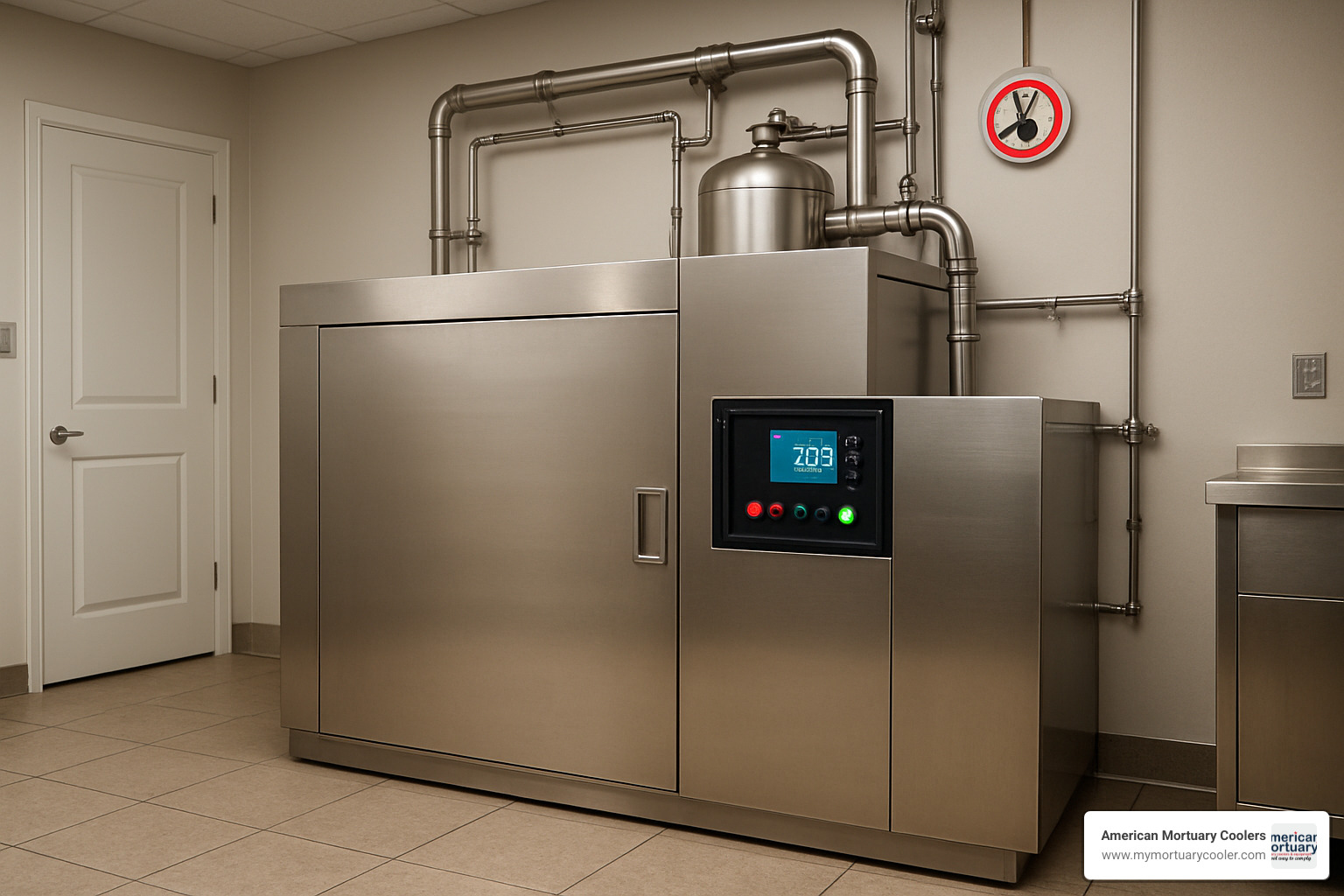
Families increasingly seek alternatives matching their values and budgets. While traditional embalming define the standard for decades, innovative preservation methods are reshaping death care.
Refrigeration has emerged as the most practical alternative. Modern mortuary coolers maintain bodies at 34-38°F, effectively preserving them for 3-7 days without chemical treatment. This eliminates formaldehyde exposure while providing families time to gather and plan services.
Aquamation (alkaline hydrolysis) uses heated water and alkali to accelerate natural decomposition, leaving only sterile bone fragments. It's environmentally gentle and produces 20% more remains than cremation.
Cryonics uses liquid nitrogen to preserve bodies at -196°C with hopes of future revival. While scientifically unproven and expensive, it demonstrates how preservation technology continues pushing boundaries.
Green burial represents the opposite extreme - no preservation at all. Bodies are buried in biodegradable materials within 24-48 hours, allowing natural decomposition. This appeals to environmentally conscious families and costs significantly less.
For funeral directors exploring options, How to Learn Embalming: 5 Methods That Guarantee Results provides insights into expanding service offerings.
Traditional embalming excels at presentation and timing flexibility but brings chemical exposure concerns. Refrigeration eliminates these issues while reducing costs, though it requires proper equipment. Aquamation offers environmental benefits but availability remains limited. Green burial minimizes environmental impact and expenses but restricts timing and viewing options.
The future likely holds a blend of approaches, with families choosing based on specific needs, values, and circumstances. We've seen funeral homes successfully integrate multiple preservation methods, using our cooling solutions to support both traditional embalming and refrigeration-only services.
Frequently Asked Questions about Embalming Define
How long does embalming preserve a body?
Embalming define as a temporary solution, not permanent preservation. Most people are surprised that embalming typically keeps a body in good condition for about one week under normal circumstances.
The timeframe depends on several factors. Body condition at death plays a huge role - someone who passed peacefully preserves longer than someone who experienced trauma or illness. Environmental conditions matter too, which is why proper mortuary cooling systems are important.
Temperature control after embalming can significantly extend preservation time. Our mortuary coolers maintain perfect environments that keep embalming results looking their best for family viewings, sometimes extending preservation to two weeks or more.
Certain conditions can shorten preservation time: high fever before death, infectious diseases, or delayed embalming (waiting more than 48 hours). Hot, humid weather also speeds up natural processes that embalming slows down.
Is embalming required for cremation or burial?
Federal law doesn't require embalming for either cremation or burial. However, state regulations and practical considerations complicate this.
For cremation, most states don't mandate embalming, especially when cremation happens within 24-48 hours. But if families want viewing before cremation, funeral homes will likely require or recommend embalming for health and presentation reasons.
For burial, direct burial without viewing typically doesn't need embalming, though check specific cemetery policies. Many states require either embalming or refrigeration if burial gets delayed beyond their timeframe - usually 24-72 hours.
Exceptions where embalming becomes mandatory include international transportation and deaths from certain infectious diseases. Always discuss your specific situation with your funeral director.
What are eco-friendly alternatives to embalming?
Refrigeration represents the most straightforward eco-friendly option. Instead of chemicals, it uses temperature control to slow decomposition naturally. Modern mortuary cooling systems can maintain bodies for extended periods without environmental impact.
Essential oil-based embalming uses plant-derived preservatives instead of formaldehyde, reducing chemical impact while providing decent preservation results for shorter timeframes.
Green burial eliminates embalming entirely, requiring burial within 24-48 hours but offering the lowest environmental impact. Aquamation uses water and alkali instead of fire, dramatically reducing energy consumption. Immediate disposition eliminates preservation needs while allowing meaningful memorial services afterward.
Conclusion
When we embalming define in its fullest sense, we're talking about one of humanity's most enduring practices - giving families time to say goodbye with dignity. This guide has taken us from ancient Egyptian tombs to modern preparation rooms, showing how embalming has evolved while keeping its heart intact: serving families during their most difficult moments.
The science behind embalming is fascinating, but what truly matters is how these technical skills translate into peace of mind for grieving families. Whether it's a military family needing time to gather from around the world or parents who aren't ready to let go, embalming provides that precious gift of time.
Throughout our years at American Mortuary Coolers, we've seen how proper equipment makes all the difference in embalming outcomes. The best embalmer can't achieve optimal results without reliable temperature control, which is why our custom mortuary coolers have become integral parts of preparation rooms nationwide.
The funeral industry continues evolving, with green alternatives and new technologies reshaping body preservation. Yet embalming remains a cornerstone service, adapting to meet changing environmental concerns and cultural needs while maintaining its essential purpose.
What strikes us most is how this field brings together science and compassion in equal measure. Behind every successful embalming is a funeral director who understands both preservation chemistry and grief psychology. This combination makes the difference between a technical procedure and true family service.
From Johnson City, Tennessee, we've supported funeral homes across all 48 contiguous states with durable, custom solutions designed for their unique needs. Every mortuary cooler we craft represents our commitment to helping funeral professionals serve families with dignity and professionalism.
Whether you're exploring mortuary science careers, researching choices for a loved one, or working to improve funeral home operations, we hope this guide provided the clarity you were seeking. Embalming may seem complex from outside, but at its core, it's about people helping people during life's most challenging transitions.
For detailed information about our morgue freezer solutions and how proper refrigeration improves embalming outcomes, explore our complete range of mortuary equipment. Our team stands ready to help you create optimal preparation room environments, backed by personalized service and direct delivery that funeral professionals expect from American Mortuary Coolers.

















